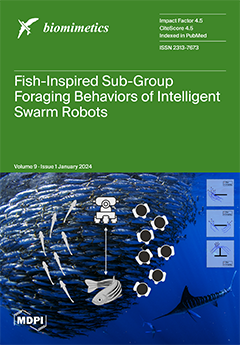Research into how fish and other aquatic organisms propel themselves offers valuable natural references for enhancing technology related to underwater devices like vehicles, propellers, and biomimetic robotics. Additionally, such research provides insights into fish evolution and ecological dynamics. This work carried out a
[...] Read more.
Research into how fish and other aquatic organisms propel themselves offers valuable natural references for enhancing technology related to underwater devices like vehicles, propellers, and biomimetic robotics. Additionally, such research provides insights into fish evolution and ecological dynamics. This work carried out a numerical investigation of the most relevant dimensionless parameters in a fish swimming environment (Reynolds
, Strouhal
, and
numbers) to provide valuable knowledge in terms of biomechanics behavior. Thus, a three-dimensional numerical study of the fish-like lambari, a BCF swimmer with carangiform kinematics, was conducted using the URANS approach with the
k-
-SST transition turbulence closure model in the OpenFOAM software. In this study, we initially reported the equilibrium Strouhal number, which is represented by
, and its dependence on the Reynolds number, denoted as
. This was performed following a power–law relationship of
. We also conducted a comprehensive analysis of the hydrodynamic forces and the effect of body undulation in fish on the production of swimming drag and thrust. Additionally, we computed propulsive and quasi-propulsive efficiencies, as well as examined the influence of the Reynolds number and
number on fish performance. Finally, we performed a vortex dynamics analysis, in which different wake configurations were revealed under variations of the dimensionless parameters
,
, and
. Furthermore, we explored the relationship between the generation of a leading-edge vortex via the caudal fin and the peak thrust production within the motion cycle.
Full article


